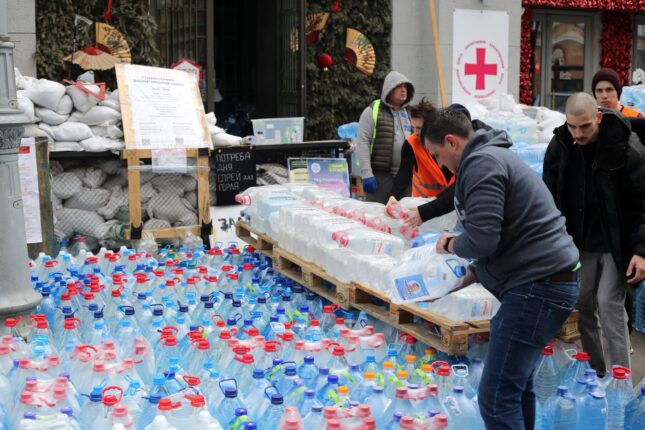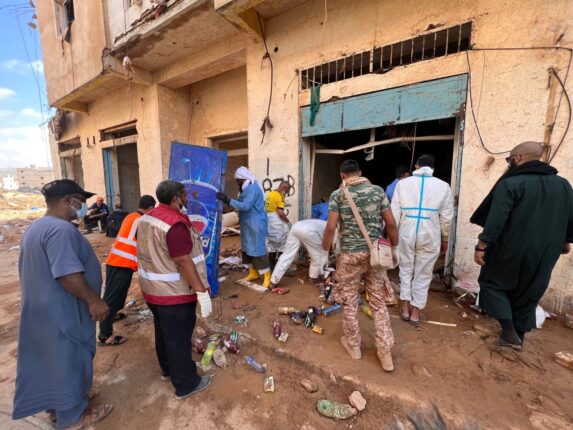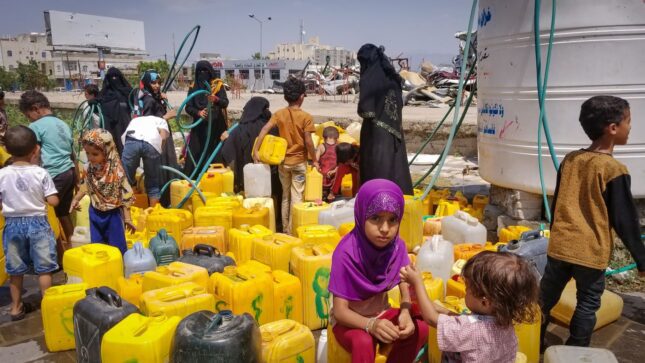-
The Global Challenge of Water’s Weaponization in War: Lessons from Yemen, Ukraine, and Libya

The world’s water is in trouble. Freshwater pollution, coupled with climate change, population growth, and increasing demand, threatens water quality and availability. Over the last 40 years, global water usage has increased every year by around 1% to support agriculture, industrial growth, and growing populations. The strain is clear already, as 26% of the world’s population lacks access to safe drinking water, and a whopping 46% lack access to basic sanitation.
In countries experiencing conflict, these dire percentages soar. In 2015, 38% of people living in conflict-affected states lacked basic drinking water, and 61% did not use basic sanitation. And the impacts on children are pronounced. UNICEF found that children under 15 who live in areas experiencing protracted conflicts are nearly three times more likely to die from diarrheal disease than from wartime violence. Children under five are more than twenty times more likely to die from diarrheal disease than violence stemming from conflict.
This grim picture is one reason why alarm bells rang in fall 2023 when an update to the Pacific Institute’s Water Conflict Chronology showed a worsening trend of water-related violence, encompassing water as a trigger of conflict, or its weaponization in warfare, or situations in which the resources itself becomes a casualty.
Yet while there is a growing awareness of the weaponization of water, what it means for those living in conflict in places like Yemen, Ukraine and Libya is much harder to disentangle.
The Rising Frequency of Water Weaponization
The weaponization of water is at once an old story and a new one. During World War II, a 1942 British air raid on Germany’s Ruhr dams did little to curb German military capabilities, but led to flooding that killed 1,300 civilians. And the steadily mounting evidence of the last 20 years has made it a story of our own moment. According to the Pacific Institute, there have been 28 incidents of water being wielded as a weapon in conflict since 2020. (The 9 years between 2000 and 2009 yielded only 32 incidents).
Water weaponization varies greatly across contexts depending on the perpetrator, motivation, and natural environment of the conflict. Marwa Daoudy defines the concept across four categories: domination and legitimacy, military tools, military targets, and cooperation. This typology allows for water weaponization to be considered both during and outside of conflict and by various state and non-state actors.
And as the additional pressures of climate change compound global water insecurity, the targeting of water supplies – or the infrastructure required to move water to where it is most needed – is having a profound and lasting impact on communities and countries along the entire conflict cycle.
These damaging tactics have been particularly devastating in the three different conflicts: Russia’s war in Ukraine, and in civil wars in Libya, and in Yemen. So we interviewed three experts on these specific regional conflicts to explore the localized impacts of an increasingly global crisis.
Russia and the War in Ukraine: State-Sanctioned Water Weaponization
Since Russia’s invasion of Ukraine just over two years ago, its attacks on the Nova Kakhovka Dam and other civilian infrastructure have drawn attention to that country’s continued willingness to use water as a weapon. The dam’s destruction displaced 3,600 people from 80 towns and villages along the Dnipro River, and cut the water supply to 1 million people. The long-term impacts of the attack on this key dam are significant. The water in the Kakhovka Reservoir was critical for irrigation-dependent agriculture in the affected regions.
Researcher Marcus King said in an interview that the deliberate destruction of civilian water infrastructure by Russia is intrinsic to their warfighting methodology: “When they besieged Mariupol, for example, they did things like intentionally cut off water as part of that maneuver. In areas where the Russians were occupying, denying access to water on a very local level is just one of the ways in which they held people hostage or terrorized the population.”
Others have taken note of the water weaponization crisis in the region. At a 2023 Wilson Center event on the impact of the conflict on water in Ukraine, Erika Weinthal said that water has been “under fire” in Ukraine since 2014, when Russia caused considerable damage to water systems as it seized Crimea and portions of eastern Ukraine.

Humanitarian aid helps provide access to water in Nikolaev, Ukraine.
The invasion of Ukraine offers tangible examples of how the interconnected nature of water and energy systems means that an attack on one system has ripple effects on the other. It takes energy to move water, and energy to run water treatment plans, observed King, so attacks on energy systems and grid infrastructure in Ukraine have also impacted water availability.
Ukraine’s water supply vulnerabilities pre-date Russia’s aggression but have been further exacerbated by the recent conflict. Sébastien Truffaut, former UNICEF Water, Sanitation, and Hygiene Chief in Ukraine noted at the 2023 Wilson Center event that major pipelines in the country have been in a state of disrepair since Ukraine’s declaration of independence. And since the majority of water companies in the country continue to rely on Soviet technologies and equipment, obtaining spare parts and repairing equipment is not possible, according to Dmytro Vankovych, director of Lviv City Communal Enterprise Water Utility.
Despite its weaponization by Russia throughout this war, water will also be key in rebuilding post-conflict, says King. Effectively doing so might provide a model for post-conflict reconstruction globally. In his comments last fall, Vankovych also noted that rebuilding will give Ukraine “the possibility to rebuild the whole model of the water industry.
Libya: Aftermath of Protracted Conflict, Disasters, and Multiple Forces of Weaponization
Whereas Ukraine’s water infrastructure has been directly targeted by Russia, Libya has fallen victim to a different kind of weaponization with catastrophic consequences, despite not being as readily identified as such.
Take the unprecedented flooding which hit the coastal city of Derna in late 2023, wiping out entire neighborhoods and civilian infrastructure. More than 4,000 people were killed, 8,500 were declared missing, and 42,000 persons were displaced by these events.
On its face, the catastrophe looks like one more example of the devastation that extreme weather events can exact on a poor country—especially as the impacts are made even more lethal by climate change. But a decade of protracted conflict—two bloody civil wars in 2011 and between 2014 to 2020—also led to poor resource management and deteriorating infrastructure. The unusually heavy rains brought to Derna by Storm Daniel collapsed two dams, releasing an estimated 30 million cubic meters of water, and magnifying the dangers created by infrastructure that is neither conflict or climate-resilient.
In an interview, Erika Weinthal noted that “In many ways, Libya helps us to grasp the multiple ways that infrastructure is targeted.” Observers often focus on the targeting of infrastructure through direct airstrikes, shelling, rocket attacks, or drone attacks. But in Libya, different actors have different interests not only in destroying infrastructure, but in capturing and controlling infrastructure as well.

Rescue operations recover a body in the city of Derna, Libya.
For instance, Weinthal said that water has been used to extract demands or concessions from warring groups, militias, and warlords. These tactics usually involve small-scale looting, sabotage, threats to personnel, and obstructing access to repairing infrastructure, rather than targeted destruction. Yet these acts can have outsized impacts on heavily centralized, heavily engineered infrastructure, as is the case of Libya’s main water utility, the Great Man-Made River Project (GMR).
The GMR is a network of pipes and aqueducts that transfers groundwater in the south to the urban centers along the northern coast, where 78.2% of the population lives. Construction on the project began in 1984 under ousted Libyan President Muammar al-Qaddafi, and since 1991, the GMR has supplied irrigation and drinking water to cities and farms in the more heavily populated north.
“No one group has tried to fully capture and control the entire Great Man-Made River,” observed Weinthal. “What we heard in our interviews was a recognition that water still unites the country, and that there was an understanding that you had to keep the infrastructure functioning to provide water to the population throughout the country.” Yet even with this recognition that everybody needs water, large feats of engineering such as the GMR are not made for war.
Weinthal added that highly centralized and sophisticated systems like the GMR offer many points of vulnerability in a protracted conflict. Infrastructure becomes difficult or impossible to maintain. Power outages can cause disruptions, spare parts are difficult to come by and systems deteriorate. “You don’t have the foreign experts who can come in and help sustain and maintain some of this infrastructure,” she said. Control centers become vulnerable if staff are taken hostage or operations disrupted. Parts of the system, like copper, are ripe for looting.
Without a recognized and stable government, Weinthal observed that reconstruction in Libya will be nearly impossible, particularly when the international community is interested in profiting from the country’s oil. There not only has to be an analysis of what failed before you can start rebuilding, but also a vision for the future. And without unity and accountability to create a clear path forward, she continued, “it’s going to be really hard to start rebuilding in Libya in a way that will be climate sensitive.”
Yemen: Nonstate Actors’ Attacks on Civilian Water Infrastructure and Health Impacts
When water supply is a direct or an indirect victim of conflict, the effects are devastating for human health. Perhaps nowhere is this more evident than in Yemen, where state and nonstate actors continue to vie for control over the country’s scarce water resources. Yemen’s civil war began in 2014 when the Houthis took control of the country’s capital. There has been a nominal ceasefire in place since 2022, yet the nation’s humanitarian crisis persists.
A Human Rights Watch (HRW) report published in December 2023 analyzed the role water weaponization played in this conflict, particularly in the city of Taizz, where Houthi armed forces and the Yemeni government vie for control over water resources. In an interview, HRW researcher Niku Jafarnia said that “each warring party in Taizz has played a role in the water crisis. For some time, government-backed forces took control of certain water infrastructure in the city center. That was when the Houthis decided to shut off the valves supplying water to the city from the parts of the city under their control. Government forces had taken over this water infrastructure and were selling water at a price to support their own forces, because they weren’t getting paid a salary. It ultimately made water infrastructure into a military target.”
Jafarnia noted that not only are water supplies being blocked by the Houthis, but there have also been documented attacks by the Saudi-led coalition on larger water infrastructure across the country—including pipes and water tankers. Water pumps and wells have been targeted as well, with devastating effects on agriculture, livelihoods, and food security. Replacing the pumps is expensive, especially due to the impacts the conflict has had on the economy, so farmers are unable to water their crops and ultimately lose their agricultural land.

The city of Taiz in South Yemen, which is affected by war, experiences a water crisis.
The humanitarian impact in Yemen has been devastating. The United Nations estimates that 60% of the 377,000 deaths there between 2015 and 2022 were attributable to food insecurity and limited access to health services, while two-thirds of the population (21.6 million people) remain in desperate need of humanitarian aid.
“It’s really hard to track the deaths that come out of weaponization of water, weaponization of food, and starvation as a method of warfare, because they often end up emerging in conjunction with people’s existing health problems,” observed Jafarnia. She offered a cholera outbreak in Taizz in 2017 that killed 2,000 civilians as an example.
“The cholera outbreak itself is a culmination of factors such as a lack of water, but it also occurred in part because of the destruction of sanitation and infrastructure,” said Jafarnia. The numbers for sick and dead are likely higher, she added, but one of the hurdles to unpacking the health impacts of the conflict is getting accurate data from Yemen at present. That data is just not available, and without it, it becomes even more challenging to demonstrate the severity of the conflict’s impacts.
One clear impact of water’s weaponization in Yemen is how acutely its effects are felt by women and girls. “It’s an area where the gender discrepancy is obvious,” said Jafarnia, “particularly among younger girls.” She cited a HRW article on the lack of water and electricity in Aden to illustrate the impact on girls’ education, even in a relatively well off and stable city.
“You see girls who don’t have an education because they must spend entire days walking hours to fetch water that is far too heavy for their bodies to carry,” said Jafarnia. “It’s a treacherous journey. Just by virtue of walking long distances in rural areas, there’s a higher likelihood that you might run into a landmine. There’s also obviously potential for encountering sexual and gender-based violence. Activists have told us that this wasn’t as large of an issue in the past, but has become more widespread recently.”
But women have also played an important role in addressing the conflict. Jafarnia noted the centrality of local actors, particularly women, in advancing negotiations. “There is a long history of advocacy in Taizz,” she said, “and with the current negotiations there, women have been leading the way.”
Rebuilding for Resilience
Several international legal frameworks work to combat the weaponization of water in conflict. Yet enforcing existing international law is nearly impossible with nonstate actors and extremely difficult with state actors. So while enhancing legal avenues may be one effective action, more immediate and innovative solutions are ultimately needed to minimize the civilian harm created by water weaponization.
King stated that in situations where non-state actors are the perpetrators, it’s important that we address the scarcity of water that enables weaponization. Investing in more resilient water infrastructure, for example, through the mobilization of climate finance could shrink the footprint of global water scarcity.
Recognizing and acting upon the climate implications of this work is essential. “We all know climate change has become this ever-looming thing,” said Jafarnia. “No matter what other work we’re doing, it is critical that everything ends up intersecting with climate and water and environment at the end of the day.”
Weinthal cited the flooding in Derna as an example of the increasing vulnerability of conflict-affected fragile countries to climate change. While she acknowledged that it is hard to know whether uninterrupted investments in water infrastructure in Libya would have prevented the flooding, the years of neglect and disrepair had an obvious impact.
When there is conflict, however, climate-resilient development is often pushed to the back burner, despite the fact that addressing issues related to food and water insecurity is a necessary piece of addressing conflict. At the same time, as all three cases point to, rebuilding must also take place with conflict-sensitivity in mind, so that water supplies are not so vulnerable to disruptions.
The attention that Russia’s aggression in Ukraine, the protracted conflict in Libya, and the crisis in Yemen have received in the media and in policy may be more prominent than that given to other ongoing conflicts where water plays a role, such as the exploitation of water by Boko Haram in Nigeria and al-Shabaab in Somalia. Yet it still does not match the urgency of these crises. All three conflicts illustrate the catastrophic and long-term impacts that war can have on civilians when their water supply is in the crosshairs of conflict—whether targeted or impacted indirectly. And as climate change compounds conflicts and water-related challenges around the world, it is important to recognize that water remains central to wartime strategy, human survival, and post-conflict recovery.
The authors wish to thank Marcus King, Niku Jafarnia, and Erika Weinthal for their valuable contributions to this article
Sources: UN Water, USAID, Pacific Institute, European Geosciences Union, University of Pennsylvania, International Affairs Journal, Wilson Center, Save the Children, OCHA, IOM, Center for Disaster Philanthropy, Middle East Institute, Human Rights Watch, Al Jazeera, UNHCR, International Committee of the Red Cross
Header Photo Credit: KHERSON, UKRAINE – Jun. 12, 2023: Lifeguards and volunteers seen evacuating helpless old people from flooded areas on stretchers, Courtesy of Drop of Light on Shutterstock.com
Second Photo Credit: Odessa, Ukraine April, 18.2022. Russia war against Ukraine. Sending drinking water to Nikolaev. Humanitarian aid in Nikolaev. Nikolaev almost a week without water, Courtesy of VyacheslavOnishchenko on Shutterstock.com
Third Photo Credit: Darnah, Libya – September 16, 2023: Rescue operations continue and the body is recovered in the city of Derna, Courtesy of Hussein Eddeb on Shutterstock.com
Fourth Photo Credit: Water crisis caused by the war in the city of Taiz South Yemen. Yemen / Taiz City. 2018-11-02, Courtesy of anasalhajj on Shutterstock.com
 A Publication of the Stimson Center.
A Publication of the Stimson Center.










